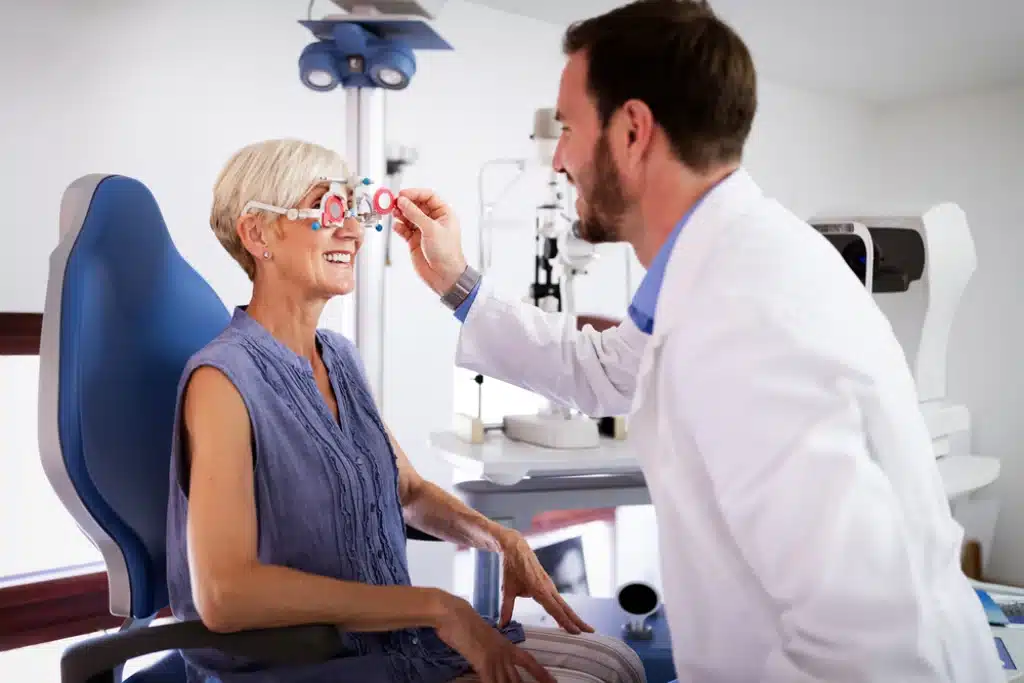Medically Reviewed by: Edward C. Wade, M.D., F.A.C.S.
What Does LASIK Surgery Do? Is it Right for You?
LASIK surgery is used to correct errors in the lens of the eye. It is a type of refractive eye surgery that remedies the way that light enters the eye which allows a person to focus on an object. People who benefit from this type of surgery include those who are nearsighted, farsighted and/or have astigmatism.
The LASIK Procedure
LASIK is a relatively quick procedure that usually takes place on an outpatient basis. It will usually only take about 15 minutes for both eyes and the results can typically can be noticed within 24 hours. Most patients report the surgery being pain free and when there is any discomfort, it is often simply dryness and minor burning sensations.
Before your surgery, you will meet with an eye doctor or coordinator to be acquainted with the procedure. The surgeon will also want to examine your eyes, check the thickness of your cornea, and corneal mapping as well as pupil dilation. To get ready for your surgery, your doctor will advise you to stop wearing rigid contact lenses for three weeks before being evaluated for surgery. Soft contacts can be worn longer but should be removed for three days prior to the surgery.
During the surgery the surgeon will use a laser to create a thin flap in the cornea. The access to the cornea allows the surgeon to reshape it so it can reflect light properly and the flap is put back to cover the lens. Numbing drops keep the eye from experiencing any pain, and the entire procedure is quick and efficient.
The Risks to LASIK
LASIK surgery is a common, 15 minute procedure with minimal to no pain. However, as with all surgeries there are some risks involved that all Lasik patients should be aware of.
Some of the possible risks to LASIK include:
- Halo glow around objects
- Night driving problems
- Eye dryness and itching
- Glare
- Vision fluctuations
Recovering from LASIK Surgery
One of the attractive things about LASIK surgery is that there are no bandages or stitches and recovery time is quick with minimal pain, allowing many patients to return to work the day after surgery. Numbing drops are used during the surgery and are given to the patient post-surgery to alleviate any minor irritation that might occur. 24 to 48 hours after surgery you will need a follow-up appointment to check on your progress. The best way for a quick recovery is to get plenty of rest following the procedure, take prescribed medications (eye drops) as directed.
Financing Options Available
Apply today to find a financing option that meets your needs.
Our Locations
Houston/Bellaire
6565 W. Loop S., Suite 650Bellaire, TX 77401
Medical Office:
713-797-1010
Medical Fax:
713-357-7276
LASIK/Near Vision:
Office: 713-395-1515
Fax: 713-357-7278
Pasadena
4415 Crenshaw RoadPasadena, TX 77504
Medical Office:
281-977-8800
Medical Fax:
281-977-8877
Sugar Land
15200 S.W. Freeway, Suite 130Sugar Land, TX 77478
Medical Office:
281-277-1010
Medical Fax:
281-277-4504
Clear Lake
455 E. Medical Center Blvd., Suite 110Webster, TX 77598
Medical Office:
281-332-1397
Medical Fax:
281-282-9152
Katy
Greenhouse Medical Plaza2051 Greenhouse Road, Suite 110
Houston, TX 77084
Medical Office:
346-547-7070
Medical Fax:
281-214-2971
The Woodlands/Conroe
100 Medical Center Blvd., Suite 118Conroe, TX 77304
Medical Office:
936-647-1610
Medical Fax:
936-647-1620


